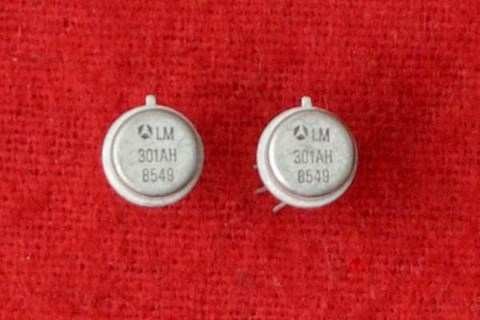LM301A
General Description
The LM101A series are general purpose operational amplifiers which feature improved performance over industry standards like the LM709. Advanced processing techniques make possible an order of magnitude reduction in input currents, and a redesign of the biasing circuitry reduces the temperature drift of input current. Improved specifications include:
• Offset voltage 3 mV maximum over temperature (LM101A/LM201A)
• Input current 100 nA maximum over temperature (LM101A/LM201A)
• Offset current 20 nA maximum over temperature (LM101A/LM201A)
• Guaranteed drift characteristics
• Offsets guaranteed over entire common mode and supply voltage ranges
• Slew rate of 10V/ms as a summing amplifier
This amplifier offers many features which make its application nearly foolproof: overload protection on the input and output, no latch-up when the common mode range is exceeded, and freedom from oscillations and compensation with a single 30 pF capacitor. It has advantages over internally compensated amplifiers in that the frequency compensation can be tailored to the particular application. For example, in low-frequency circuits, it can be overcompensated for increased stability margin. Or the compensation can be optimised to give more than a factor of ten improvements in high-frequency performance for most applications.
Also, the device provides better accuracy and lower noise in high impedance circuitry. The small input currents also make it particularly well suited for long interval integrators or timers, sample and hold circuits and low-frequency waveform generators. Further, replacing circuits where matched transistor pairs buffer the inputs of conventional IC op-amps, it can give lower offset voltage and drift at a lower cost.
The LM101A is guaranteed over a temperature range of -55°C to +125°C, the LM201A from -25°C to +85°C, and the LM301A from 0°C to +70°C.
Functional Description
Although the LM101A is designed for trouble-free operation, experience has indicated that it is wise to observe certain precautions given below to protect the devices from abnormal operating conditions. It might be pointed out that the advice given here applies to practically any IC op amp, although the exact reason why may differ with different devices.
When driving either input from a low-impedance source, a limiting resistor should be placed in series with the input lead to limit the peak instantaneous output current of the source to something less than 100 mA. This is especially important when the inputs go outside a piece of equipment where they could accidentally be connected to high voltage sources. Large capacitors on the input (greater than 0.1 µF) should be treated as a low source impedance and isolated with a resistor. Low impedance sources do not cause a problem unless their output voltage exceeds the supply voltage. However, the supplies go to zero when they are turned off, so the isolation is usually needed.
The output circuitry is protected against damage from shorts to ground. However, when the amplifier output is connected to a test point, it should be isolated by a limiting resistor, as test points frequently get shorted to wrong places. Further, when the amplifier drives a load external to the equipment, it is also advisable to use some sort of limiting resistance to preclude mishaps.
Precautions should be taken to ensure that the power supplies for the integrated circuit never become reversed even under transient conditions. With reverse voltages higher than 1V, the IC will conduct excessive current, fusing internal aluminium interconnects. If there is a possibility of this happening, clamp diodes with a high peak current rating should be installed on the supply lines. Reversal of the voltage between V+ and V- will always cause a problem, although reversals to ground may also give difficulties in many circuits.
The minimum values given for the frequency compensation capacitor are stable only for source resistances less than 10 kΩ, stray capacitances on the summing junction less than 5 pF and capacitive loads smaller than 100pF. If any of these conditions are not met, it becomes necessary to overcompensate the amplifier with a larger compensation capacitor. Alternately, leads capacitors can be used in the feedback network to negate the effect of stray capacitance and large feedback resistors or an RC network can be added to isolate capacitive loads.
Although the LM101A is relatively unaffected by supply bypassing, this cannot be ignored altogether. Generally, it is necessary to bypass the supplies to the ground at least once on every circuit card, and more bypass points may be required if more than five amplifiers are used. When feed-forward compensation is employed, however, it is advisable to bypass the supply leads of each amplifier with low inductance capacitors because of the higher frequencies involved.
